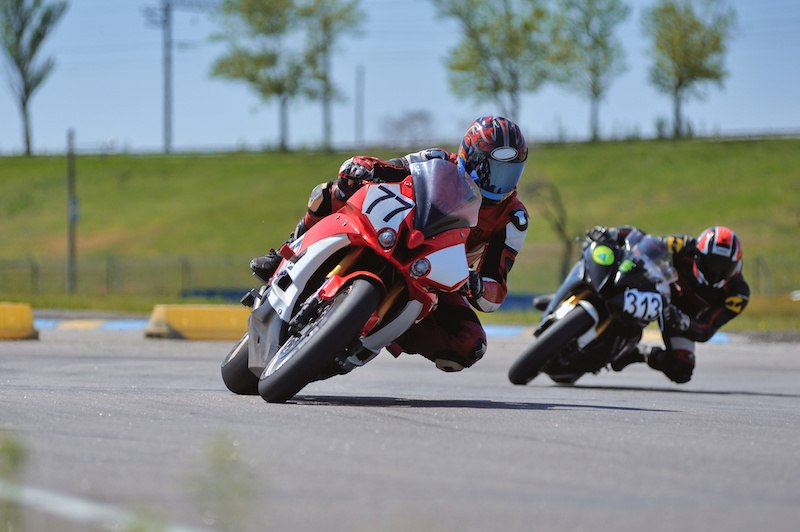If you were wondering whether you had to spring for a full-frame camera with all the bells and whistles to photograph motorsports, the good news is that, no, you don’t.
Today’s micro four-thirds cameras have a tremendous trackside manner. Fast shutter speeds, quick AF, and capable zoom lenses combine to help you catch all the spills and thrills of the day.
have a tremendous trackside manner. Fast shutter speeds, quick AF, and capable zoom lenses combine to help you catch all the spills and thrills of the day.
With that said, you must remember that micro
However, that doesn’t mean your results will be disappointing, but you do need to learn to work within your limitations and plan your shoot.
Here are a few tips you can keep in mind for your next outing so you can go home with photos you’ll be proud to show off to your motorhead friends.
The Planning Phase
Some of the photographers you will see trackside will be snapping away with tens of thousands of dollars worth of gear and a choice between two or three expensive camera bodies.
bodies.
 , but with some planning, you can use your limited hardware to get some excellent shots.
, but with some planning, you can use your limited hardware to get some excellent shots.
Try to get yourself situated on a slow corner to have a little latitude with the shutter speed.
It would be best to achieve more exciting compositions when you are not shooting the cars straight on. But instead at an angle, as they fight for traction through the apex.
It’s exciting stuff when you can manage a shot where the rubber leaves the road – even better if it’s two wheels and not one.
Panning is where you use slower shutter speeds while physically following the car with your camera. It takes some practice, but the results are worth it if you can pull it off.
If you can keep the car in perfect focus, the blur of the background and spinning wheels will perfectly illustrate the pure speed and adrenaline of the event.
Experiment with Shutter Speed
Shutter speeds on micro four-thirds cameras are getting pretty quick. Even at the budget end of the spectrum, you can achieve shutter speeds of 1/4000th of a second.
When it comes to motorsport photography, you can have a lot of fun with shutter speed. Keep it fast, and your cars will look stationary. Slow it down a little, and you’ll get some motion blur to convey that all-important sense of speed.
Developing your skills in panning, as described above, will help you get some action in your shots because you can get away with a slower shutter speed.
If you’re at the dirt track, the flying debris will give you all the sense of the action you need, so a shutter speed of 1/500th may provide you with good results. Experiment on the day to see what will work best in the conditions.
Setting the Aperture
Unlike sports photography, which often requires a large aperture to put the subject in sharp focus, motor racing needs a different tactic.
A smaller aperture allows a larger depth of field, so you don’t have to be as precise with your focus points.
You can put your focus on the bike rider or the vehicle when you pan, but either way, you should have enough depth of field to keep all the action in the frame and in focus.
Use Manual Focus
If you want breakneck autofocus speeds, you’ll need an insanely priced DSLR. Micro four-thirds AF speeds are excellent for people shots and have improved with each generation.
However, at the budget end of the market, cars and motorbikes could give your camera’s autofocus system a run for its money.
You can get around this by using manual mode and pre-focusing your camera at the point you want to photograph.
Find something for the camera to focus on at the same distance as the vehicle, set the focus, and lock it in. Now you have to wait for your subject to move into the zone.
Burst Mode is Your Friend
The best way to look like a skillful photographer on the track is to take many images. Burst mode increases your chances that at least one of the photos will be a keeper for the portfolio.
Setting your ISO
Even relatively cheap micro four-thirds cameras are capable of high ISO settings without adding in too much noise.
This capability is good news for motorsports fans as you never know when the clouds will roll in to try and spoil your afternoon.
You’ll always get better results if you expose your image with higher ISOs, as you give yourself more options in post-processing. You miss out on a lot of detail with lower ISO settings, which is impossible to add after the fact.
You will also introduce a lot of digital noise if you try to increase the exposure of an under-exposed shot in post-processing.
Don’t Just Focus on the Cars
Of course, motorsport photography is all about the cars, but it wouldn’t exist without all the fans bringing excitement to the day.
Shift your focus away from the vehicles and try to capture the energy of the day via a few photos of the excited crowd, a pit crew hard at work (you may need a good zoom lens), or over-enthusiastic fans leaning over the fence to show their support for their favorite drivers.
Recommended Micro Four Thirds Camera for Motorsports
If you need fast AF in a micro four thirds and have the budget, the OM-D E-M1 Mark II has impressed motorsports photographers with its professional-level results.
Part of the appeal with micro four-thirds is their compact nature, and this extends to the lenses you will need to take with you to the track.
An OM-D E-M1 Mark II combined with the M.Zuiko Digital ED 40- 150 mm F2.8 PRO would give you the combined capabilities of two lenses (a 70-200mm f2.8 and 300mm F2.8) if you were carrying a full-frame camera.
The weather-sealed sturdy construction gives you a camera you can confidently use with the unpredictable environment and weather typical of the average race day.
gives you a camera you can confidently use with the unpredictable environment and weather typical of the average race day.


